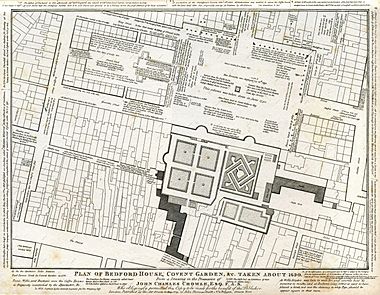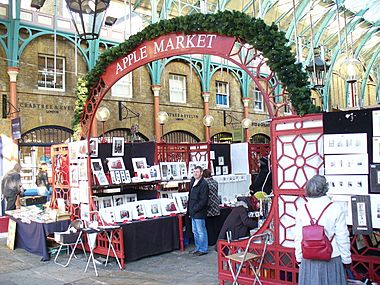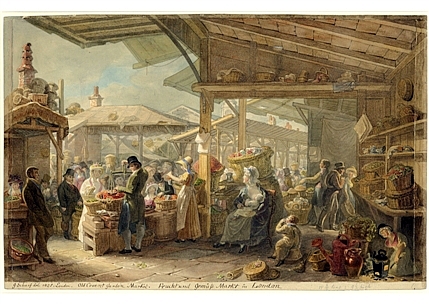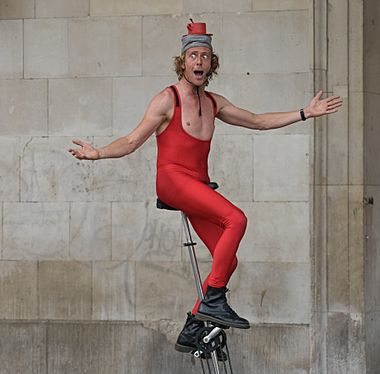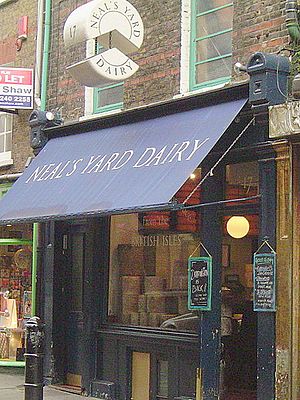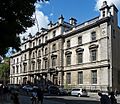Covent Garden facts for kids
Quick facts for kids Covent Garden |
|
|---|---|
 Inside the old vegetable market, 2006 |
|
| OS grid reference | TQ303809 |
| London borough | |
| Ceremonial county | Greater London |
| Region | |
| Country | England |
| Sovereign state | United Kingdom |
| Post town | LONDON |
| Postcode district | WC2 |
| Police | Metropolitan |
| Fire | London |
| Ambulance | London |
| EU Parliament | London |
| UK Parliament |
|
| London Assembly |
|
Covent Garden is a lively area in London, located in the eastern part of the West End. It's famous for its old fruit and vegetable market, which is now a popular place for shopping and tourists. The area is also home to the Royal Opera House, often called "Covent Garden" itself.
Covent Garden is split by a main street called Long Acre. North of Long Acre, you'll find unique shops around Neal's Yard and Seven Dials. South of Long Acre is the main square with street performers, historic buildings, theatres, and fun places like the London Transport Museum and the Theatre Royal, Drury Lane.
This area was once just open fields. In the 7th century, it became the heart of an Anglo-Saxon trading town called Lundenwic. Later, it went back to being fields. Around 1200, the monks of Westminster Abbey used part of it as a garden and orchard, calling it "the garden of the Abbey and Convent," which later became "the Convent Garden."
After the monasteries were closed down, King Edward VI gave the land to John Russell, 1st Earl of Bedford in 1552. The 4th Earl of Bedford, Francis Russell, hired a famous architect named Inigo Jones to design beautiful houses around a large square, along with the church of St Paul's. This new square design was very important for how London grew, setting an example for other new areas.
By 1654, a small outdoor fruit and vegetable market started on the south side of the square. Over time, the market grew, and more buildings were added, like the Floral Hall and the Jubilee Market. By the 1960s, traffic became a big problem, so the market moved to a new location in 1974. The central building in Covent Garden re-opened as a shopping centre in 1980. Today, it's a popular tourist spot with cafes, shops, and a craft market called the Apple Market.
Covent Garden is part of the London boroughs of Westminster and Camden. You can easily get there by tube, as the Piccadilly line has a station there called Covent Garden tube station.
Contents
History of Covent Garden
How Covent Garden Began
The area that is now Covent Garden was once part of a Roman road to Silchester. For a long time, people thought this area was just empty fields until the 1500s. However, discoveries in 1985 and 2005 showed that Covent Garden was actually the centre of an Anglo-Saxon trading town called Lundenwic. This town started around 600 AD and stretched from Trafalgar Square to Aldwych. Later, Alfred the Great moved the settlement into the old Roman town of Londinium, and the Covent Garden area went back to being fields.
Around 1200 AD, a document mentions a walled garden owned by the monks of Westminster Abbey. This garden was about 40-acre (16 ha) of orchards, meadows, and farmland. The name "Covent" comes from an old Anglo-French word for a religious community, like a monastery. In 1515, the Abbey leased out this walled garden, calling it "a garden called Covent Garden." That's how the name stuck!
The Bedford Family's Influence (1552–1918)

After King Henry VIII closed down the monasteries in 1540, he took the land that belonged to Westminster Abbey, including the convent garden. In 1552, his son, King Edward VI, gave this land to John Russell, 1st Earl of Bedford. The Russell family, who later became the Dukes of Bedford, owned this land until 1918.
The 4th Earl of Bedford, Francis Russell, was a very active businessman. In 1630, he asked the famous architect Inigo Jones to design a church and three rows of grand houses around a large square. This project was partly because King Charles I didn't like the condition of the roads and houses in the area. The King gave Russell permission to build new houses for a fee of £2,000.
Modern Changes and the Market's Move
In 1962, the government-owned Covent Garden Authority bought most of the properties in the area, including the market. By the late 1960s, traffic was a huge problem for the market, as large trucks needed to deliver goods. Big plans were made to redevelop the area. However, local people protested, and in 1973, many buildings around the square were protected, stopping the redevelopment.
The next year, in 1974, the market moved to a new site in south-west London called New Covent Garden Market. The central building in Covent Garden square was empty for a while until it re-opened as a shopping centre in 1980. It now has cafes, pubs, small shops, and a craft market called the Apple Market.
In 2004, Westminster Council made a plan to improve the area while keeping its historic feel. In 2006, a property company bought the market buildings and other properties in Covent Garden.
Geography of Covent Garden
Historically, Covent Garden was defined by Drury Lane to the east, the Strand to the south, St Martin's Lane to the west, and Long Acre to the north. However, over time, the area considered Covent Garden has grown northwards past Long Acre to High Holborn.
Long Acre is the main road, running from St Martin's Lane to Drury Lane. Shelton Street, which runs north of Long Acre, marks the border between the London boroughs of Camden and Westminster.
South of Long Acre, you'll find the Royal Opera House, the market, the main square, and most of the grand buildings, theatres, and entertainment places. This includes the Theatre Royal, Drury Lane and the London Transport Museum. North of Long Acre, the area is mostly independent shops around Neal Street, Neal's Yard, and Seven Dials. This northern part also has homes for about 7,000 residents.
 |
St Giles | Bloomsbury | Holborn |  |
| Leicester Square | Lincoln's Inn Fields | |||
| Trafalgar Square | Strand | Temple |
Famous Landmarks in Covent Garden
The Royal Opera House
The Royal Opera House, often simply called "Covent Garden," was first built as the "Theatre Royal" in 1732. For its first 100 years, it was mainly a playhouse. In 1734, the first ballet was performed here, and a year later, Handel started his opera seasons. Many of his operas were written specifically for Covent Garden. Since 1945, it has been the home of The Royal Opera, and since 1946, The Royal Ballet.
The building you see today is the third theatre on this spot, as the previous ones were destroyed by fires in 1808 and 1857. The front, foyer, and main hall were designed in 1858. However, most of the building was rebuilt in the 1990s in a huge £178 million project. The main hall is a Grade 1 listed building, meaning it's very important historically. The old Floral Hall, which was part of the market, was added to the Opera House, creating a large public space.
Covent Garden Square
The main square in Covent Garden is simply called "Covent Garden," or sometimes "Covent Garden Piazza." It was designed in 1630 and was London's first modern square. It started as an open space, and a casual market began on its south side. By 1830, the current market hall was built.
The square is very popular with street performers. They have to audition to get a spot to perform there. The square was designed by Inigo Jones for the 4th Earl of Bedford. Jones was inspired by modern town squares he saw in Europe, like those in Italy and Paris. This design was new to London and greatly influenced how new areas were planned as the city grew.
The church of St Paul's was the first building, started in 1631 on the west side of the square. The last house was finished in 1637. None of Inigo Jones's original houses remain today, though parts of some were rebuilt later.
Covent Garden Market
The first mention of a market in Covent Garden was in 1654, when traders set up stalls against the wall of Bedford House. In 1670, the Earl of Bedford received special permission from King Charles II to hold a fruit and vegetable market every day except Sundays and Christmas.
The original market, with its wooden stalls, became quite messy. So, in 1813, the 6th Duke of Bedford asked for a law to help organize it. Then, in 1830, he hired Charles Fowler to design the beautiful market building that is still the heart of Covent Garden today. More buildings were added later, like the Floral Hall and the Jubilee Market.
By the late 1960s, the market was causing huge traffic problems because of the large trucks needed for deliveries. After protests from local groups, many buildings around the square were protected in 1973, stopping redevelopment plans. The next year, in 1974, the market moved to its new location, New Covent Garden Market, about three miles away.
The central building in Covent Garden re-opened as a shopping centre in 1980. It now has cafes, pubs, small shops, and a craft market called the Apple Market. Another market, the Jubilee Market, is held in the Jubilee Hall on the south side of the square.
Theatre Royal, Drury Lane
The current Theatre Royal on Drury Lane is the fourth theatre on this site. The first one opened in 1663, making it London's oldest continuously used theatre. For much of its early history, it was one of London's most important theatres, with special rights to perform plays. Famous actors like Nell Gwyn performed here.
After the first theatre burned down in 1672, a larger one was built in 1674. This theatre lasted nearly 120 years. In 1791, that building was torn down for an even bigger theatre, which opened in 1794 but also burned down in 1809. The building you see today opened in 1812. Many famous performers have appeared here, from Shakespearean actors to the comedy group Monty Python. Since 2008, the theatre has been owned by composer Andrew Lloyd Webber and usually stages popular musical shows. It is a Grade I listed building.
London Transport Museum
The London Transport Museum is located in a beautiful Victorian building made of iron and glass, on the east side of the market square. This building was originally designed as a flower market in 1871. The museum moved into it in 1980.
The museum's collection started in the early 1900s when the London General Omnibus Company began saving old buses. Over time, the collection grew to include trains and other vehicles. Today, the Covent Garden building displays many buses, trams, trolleybuses, and rail vehicles from the 19th and 20th centuries. It also has exhibits about how transport has shaped London and its people.
St Paul's Church
St Paul's Church, often called the Actors' Church, was built in 1633. It cost £4,000 to build and was officially recognized in 1638. In 1645, Covent Garden became its own parish, and the church was dedicated to St Paul. It's not clear how much of the original building by Inigo Jones is left, as the church was damaged by fire in 1795. The columns are thought to be original, but most of the rest was rebuilt later.
Freemasons' Hall
Freemasons' Hall is the main building for the United Grand Lodge of England, a large Masonic group. It's also a meeting place for many Masonic Lodges in London. It's located on Great Queen Street, between Holborn and Covent Garden, and has been a Masonic meeting place since 1775. Parts of the building are open to the public every day. Its classic Art Deco style makes it a popular spot for filming movies and TV shows, and it's a tourist attraction.
Culture and Entertainment
Covent Garden has always been known for entertainment and shopping. It has 13 theatres and over 60 pubs and bars, mostly south of Long Acre, near the main market area. The Seven Dials area in the north of Covent Garden was home to the famous punk rock club The Roxy in 1977. Today, this area is still popular with young people, offering trendy shops.
Street Performance
Street entertainment in Covent Garden has a long history. In 1662, Samuel Pepys wrote in his diary about seeing the first Punch and Judy show in Britain here. Today, Covent Garden is officially licensed for street entertainment. Performers audition to get scheduled spots in different areas around the market, like the North Hall and West Piazza. The courtyard area is only for classical music. You can find street performances at Covent Garden Market every day of the year, except Christmas Day. Shows run all day and usually last about 30 minutes.
Pubs and Bars
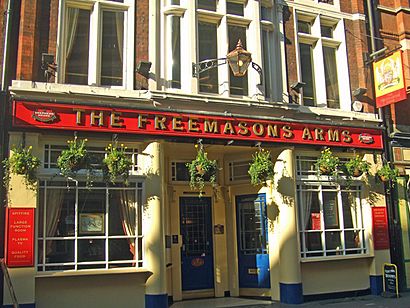
The Covent Garden area has more than 60 pubs and bars. Many of them are historic buildings, and some are even listed on the CAMRA's National Inventory of Historic Pub Interiors. Some, like The Harp in Chandos Place, have won awards. The Harp was named London Pub of the Year in 2008 and National Pub of the Year by CAMRA in 2011.
The Lamb and Flag in Rose Street is thought to be the oldest pub in the area, though its exact age is unclear. It was first mentioned in 1772. In the early 1800s, it was known for hosting bare-knuckle boxing matches, earning it the nickname "Bucket of Blood."
The Salisbury in St Martin's Lane was built around 1899. It's a Grade II listed building and is famous for its beautiful etched glass and carved woodwork from the late 1800s. The Freemasons Arms on Long Acre is sometimes linked to the founding of the Football Association, but those meetings actually took place at a different Freemason's Tavern nearby.
Restaurants
Covent Garden offers a wide variety of restaurants, especially around the main square and in the St Martin's Lane area. Some of these restaurants are very well-known. Among the oldest are historic places like Rules, founded in 1798, making it London's oldest restaurant. Then there's J. Sheekey, an oyster and fish restaurant started in 1893, and The Ivy, which began as an Italian cafe in 1917.
Other popular restaurants include Belgo Centraal, known for its Belgian food, and one of Jamie Oliver's Italian restaurants, which opened in 2007. You can also find Gaby's Deli, a Jewish cafe serving falafels since 1965, and Mon Plaisir, one of London's oldest French restaurants, founded in 1943. Covent Garden was also home to some of London's first coffee shops.
Cultural Connections
Covent Garden, especially its market, has appeared in many books and shows. In 1867, the Austrian composer Johann Strauss II wrote a piece called "Memory of Covent Garden." Eliza Doolittle, the main character in George Bernard Shaw's play Pygmalion and the musical My Fair Lady, is a flower seller from Covent Garden. The daily life of the market was also the subject of a 1957 documentary film called Every Day Except Christmas.
Getting Around Covent Garden
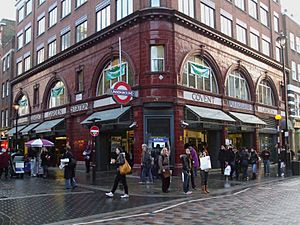
Covent Garden tube station is located on the corner of Long Acre and James Street. It's on the Piccadilly line, which connects the area to important places like King's Cross St Pancras, South Kensington, and Heathrow Airport (![]() ). The station opened in 1907. It's one of the few stations in central London where you can only reach the platforms by lift or stairs.
). The station opened in 1907. It's one of the few stations in central London where you can only reach the platforms by lift or stairs.
The journey from Covent Garden to Leicester Square tube station is London's shortest tube ride, less than 300 yards. Leicester Square station is on both the Piccadilly and Northern lines. The Northern line connects Covent Garden directly to places like Waterloo, Euston, and Camden Town.
Other nearby tube stations include Charing Cross, Embankment, and Holborn. Charing Cross is the closest main train station to Covent Garden.
More than 30 London Buses routes run around the edges of Covent Garden. No bus routes go directly through the area anymore. The Quietway 1 cycle route also passes through Covent Garden, offering a quieter way for cyclists to get around. The Santander Cycles bike sharing scheme also has several docking points in Covent Garden.
Economy and Shopping
Covent Garden Market re-opened in 1980 as a shopping area with restaurants and a pub. The main hall has shops, cafes, and bars, along with the Apple Market stalls that sell antiques, jewellery, clothes, and gifts. There are also other stalls in the Jubilee Hall Market on the south side of the square. In 2010, what was then the largest Apple Store in the world opened in The Piazza. Long Acre has many clothes shops and boutiques, and Neal Street is known for its many shoe shops. The London Transport Museum and the Royal Opera House box office are also located on the square.
The market halls and several other buildings in Covent Garden have been owned by a property company called CapCo since 2006. They pay a special "peppercorn rent" of one red apple and a posy of flowers each year, and the company helps protect the historic properties from being redeveloped.
Images for kids
See also
 In Spanish: Covent Garden (Londres) para niños
In Spanish: Covent Garden (Londres) para niños




